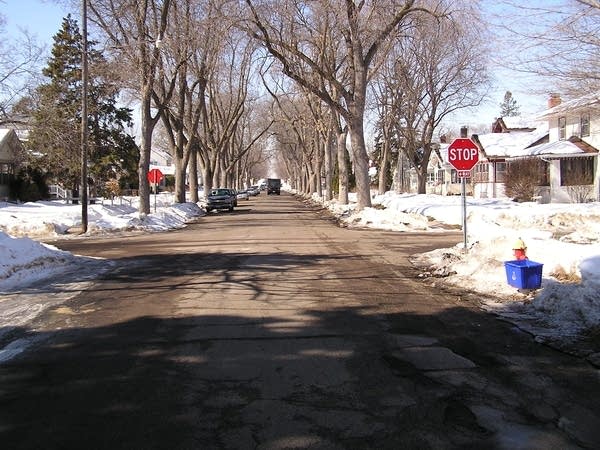$16M slated for better biking and walking in the Twin Cities

There's good news for walkers and bicyclists in the Twin Cities, not only are temperatures warming and snow banks receding but there will also be $16 million spent this year to improve biking and walking in Minneapolis and some surrounding communities.
Officials are putting the finishing touches on plans to build and expand 40 routes and make numerous intersection improvements for walkers. The net result in Minneapolis will nearly double--from 43 to 80--the number of miles of bike routes and paths.
Improving safety
It's wise to look both ways when crossing the intersection at the historic Seven Corners area in Minneapolis' West Bank neighborhood. It's where two busy four lane streets, Washington and Cedar, meet, next to the University of Minnesota.
Create a More Connected Minnesota
MPR News is your trusted resource for the news you need. With your support, MPR News brings accessible, courageous journalism and authentic conversation to everyone - free of paywalls and barriers. Your gift makes a difference.
There is a lot of traffic and a lot of people and one of the city's highest rates of vehicles hitting pedestrians. The main problem at the intersection is left-turning motorists not seeing the pedestrian crossing.
"We're going to provide funds for bump outs or curb extensions, shortening those distances quite a bit, so the pedestrian doesn't have quite so far to go," said Steve Clark, program director for the federally-funded Bike Walk program operated by Transit for Livable Communities, A St. Paul nonprofit. "We're also going to add pedestrian refuge islands so that if you can't get across the street while it still says walk you have a place to have sanctuary."
Clark said the changes will be in place by this fall, but the result may increase driver frustration.

Every rush hour the area is jammed with drivers coming off or jockeying to get on freeway 35W a block away. Many drivers regard anything or anyone slowing their progress as an impediment.
However, Steve Clark's view is driver behavior toward walkers and cyclists improves when they see medians or other roadway changes.
"It provides an immediate cue to the motorist, 'OK I need to start looking for pedestrians,'" Clark said.
Measured against the billions spent on roads and bridges in this country, $16 million to encourage biking and walking in Minneapolis is spare change. However, even a decade ago biking and walking were seldom considered anything more than recreation.
The money being spent around the country to build more bike routes and improve intersections is evidence they are now seen as legitimate forms of transportation.
Minneapolis is one of four areas in the country to win the federal funds. The others are Sheboygan County in Wisconsin, Columbia, Mo. and Marin County, Calif.
Why Minneapolis?
Shaun Murphy, Minneapolis' non-motorized projects coordinator, said one reason may be the city's large number of bike commuters, second behind Portland among the country's largest cities.
"We have about 8,000 biking to work every day and about 17,000 people walking to work every day who live here," Murphy said. "It's going to be a big change for the public because most people still get around by driving alone to work. About 70 percent of our residents still drive alone."
Another change to encourage bike traffic is putting some Minneapolis streets on a diet. A handful of four-lane streets will be reduced to three to make room for bike lanes.
More people bicycling and walking may seem like a recipe for more accidents in our car-oriented culture. However, Murphy said crashes between bikes and cars, for example, are down from between the 1990s and the last decade by almost 20 percent even as bicycling numbers are rising.
Not everyone is on board with the biking and walking improvement plans.
Residents in St. Paul's Macalester-Groveland neighborhood are divided over the plan to designate Jefferson Avenue a bike route.

Mac-Groveland Community Council transportation committee chair Amber Dallman said the objections caused St. Paul public works officials to eliminate so-called traffic calming changes on portions of Jefferson.
"For example, speed humps or tables, traffic circles, parking on the north side of the street in some areas," Dallman said.
St. Paul public works officials are holding off making final plans for the Jefferson Avenue bike route until residents' concerns are addressed.
Minneapolis has been creating biking and walking paths for decades, but mostly next to lakes and in parks where there's not much interaction with cars. The near doubling of bike routes on city streets this year marks a historic turn for the city.
Along with improvements for walkers at intersections the changes present challenges as people on foot, on bikes and in vehicles adjust to make room for one another.
-----
Go to Transportation Nation for more of the latest transportation news from all across America.
